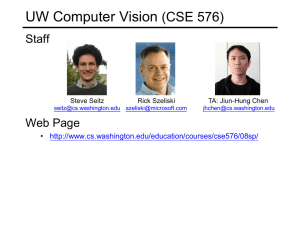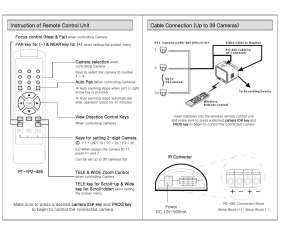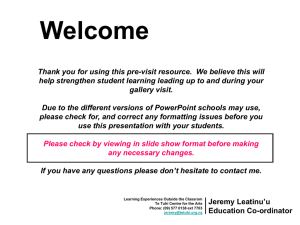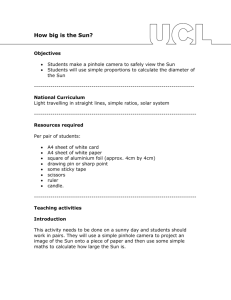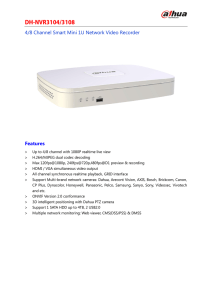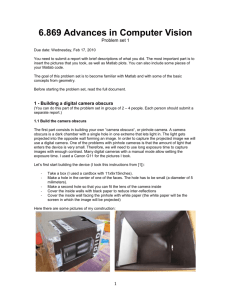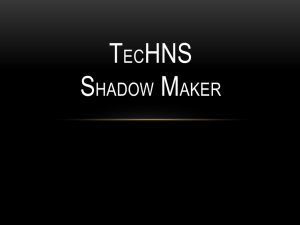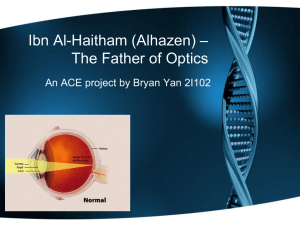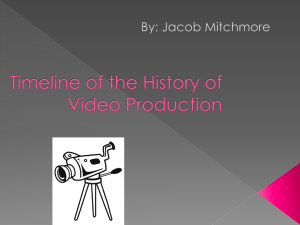01Introduction - Electrical Engineering & Computer Sciences
advertisement
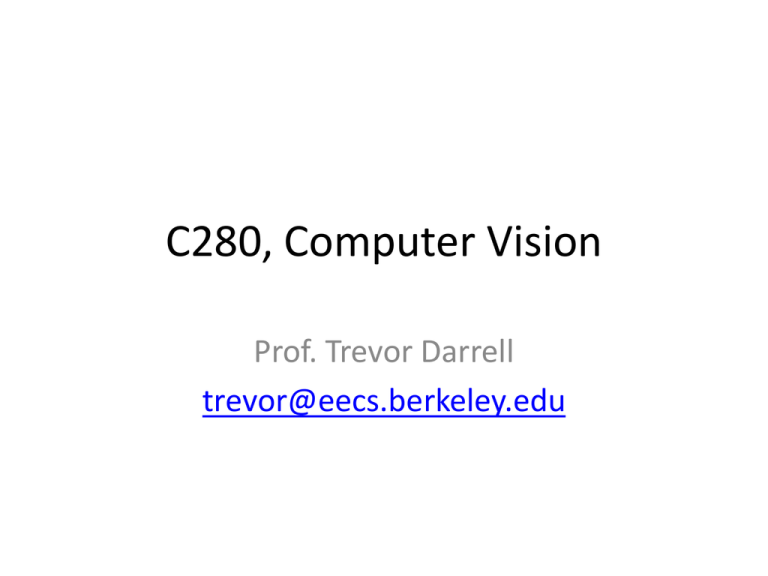
C280, Computer Vision Prof. Trevor Darrell trevor@eecs.berkeley.edu Today • • • • • Administrivia “What is vision?” Schedule Introductions Image formation Prerequisites • This course is appropriate as a first course for graduate students with a EECS background, which should have prepared the students with these essential prerequisites: – Data structures – A good working knowledge of MATLAB programming (or willingness and time to pick it up quickly!) – Linear algebra – Vector calculus • The course does not assume prior imaging experience, computer vision, image processing, or graphics Text • The primary course text will be Rick Szeliski’s draft Computer Vision: Algorithms and Applications; we will use an online copy of the June 19th draft. • The secondary text is Forsyth and Ponce, Computer Vision: A Modern Approach. Primary Text Secondary Text Matlab • Problem sets and projects will involve Matlab programming (you are free to use alternative packages). Matlab runs on all the Instructional Windows and UNIX systems. Instructions and toolkits are described in http://inst.eecs.berkeley.edu/cgi-bin/pub.cgi?file=matlab.help. • CS280 students can use their existing EECS Windows accounts in EECS instructional labs, and they can request new accounts (for non-majors) or additional access to Instructional resources by following the instructions about ’named’ accounts in http://inst.eecs.berkeley.edu/connecting.html#accounts. They can logon remotely and run it on some of our servers: http://inst.eecs.berkeley.edu/connecting.html#labs Grading • There will be three equal components to the course grade – Five problem sets – A take-home exam – Final project (including evaluation of proposal document, in-class presentation, and final report) • In addition, strong class participation can offset negative performance in any one of the above components. Problem sets • • • • • • Pset0 – Basic Image Manipulation in Matlab Pset1 – Filtering and Features Pset2 – Geometry and Calibration Pset3 – Recognition Pset4 – Stereo and Motion Can discuss, but must submit individual work Take-home • • • • Limited time: 3 days Covers everything through hand out date Little programming *No discussion or collaboration allowed* Final project • Significant novel implementation of technique related to course content • Teams of 2 encouraged (document role!) • Or journal length review article (no teams) • Three components: – proposal document (no more than 5 pages) – in class results presentation (10 minutes) – final write-up (no more than 15 pages) Class Participation • Class participation includes – showing up – being able to articulate key points from last lecture – having read assigned sections and being able to “fill in the blank” during the lecture • I won’t cold call, but will solicit volunteers • Strong in-class participation can offset poor performance in one of the other grade components. Course goals….(broadly speaking) • • • • • • • • principles of image formation convolution and image pyramids local feature analysis multi-view geometry image warping and stitching structure from motion visual recognition image-based rendering What is computer vision? Done? What is computer vision? • Automatic understanding of images and video – Computing properties of the 3D world from visual data (measurement) – Algorithms and representations to allow a machine to recognize objects, people, scenes, and activities. (perception and interpretation) Vision for measurement Real-time stereo Structure from motion Multi-view stereo for community photo collections NASA Mars Rover Pollefeys et al. Goesele et al. Slide credit: L. Lazebnik Vision for perception, interpretation amusement park sky The Wicked Twister Cedar Point Ferris wheel ride Lake Erie ride 12 E water ride tree tree Objects Activities Scenes Locations Text / writing Faces Gestures Motions Emotions… people waiting in line people sitting on ride umbrellas tree deck maxair carousel bench tree pedestrians Related disciplines Artificial intelligence Graphics Image processing Computer vision Algorithms Machine learning Cognitive science Vision and graphics Images Vision Model Graphics Inverse problems: analysis and synthesis. Why vision? • As image sources multiply, so do applications – Relieve humans of boring, easy tasks – Enhance human abilities: human-computer interaction, visualization – Perception for robotics / autonomous agents – Organize and give access to visual content Why vision? • Images and video are everywhere! Personal photo albums Surveillance and security Movies, news, sports Medical and scientific images Slide credit; L. Lazebnik Again, what is computer vision? • Mathematics of geometry of image formation? • Statistics of the natural world? • Models for neuroscience? • Engineering methods for matching images? • Science Fiction? Vision Demo? Terminator 2 we’re not quite there yet…. Every picture tells a story • Goal of computer vision is to write computer programs that can interpret images Can computers match (or beat) human vision? • Yes and no (but mostly no!) – humans are much better at “hard” things – computers can be better at “easy” things Human perception has its shortcomings… Sinha and Poggio, Nature, 1996 Copyright A.Kitaoka 2003 Current state of the art • The next slides show some examples of what current vision systems can do Earth viewers (3D modeling) Image from Microsoft’s Virtual Earth (see also: Google Earth) Photosynth http://labs.live.com/photosynth/ Based on Photo Tourism technology developed by Noah Snavely, Steve Seitz, and Rick Szeliski Photo Tourism overview Scene reconstruction Input photographs Photo Explorer Relative camera positions and orientations Point cloud Sparse correspondence System for interactive browsing and exploring large collections of photos of a scene. Computes viewpoint of each photo as well as a sparse 3d model of the scene. Photo Tourism overview Optical character recognition (OCR) Technology to convert scanned docs to text • If you have a scanner, it probably came with OCR software Digit recognition, AT&T labs http://www.research.att.com/~yann/ License plate readers http://en.wikipedia.org/wiki/Automatic_number_plate_recognition Face detection • Many new digital cameras now detect faces – Canon, Sony, Fuji, … Smile detection? Sony Cyber-shot® T70 Digital Still Camera Object recognition (in supermarkets) LaneHawk by EvolutionRobotics “A smart camera is flush-mounted in the checkout lane, continuously watching for items. When an item is detected and recognized, the cashier verifies the quantity of items that were found under the basket, and continues to close the transaction. The item can remain under the basket, and with LaneHawk,you are assured to get paid for it… “ Face recognition Who is she? Vision-based biometrics “How the Afghan Girl was Identified by Her Iris Patterns” Read the story Login without a password… Fingerprint scanners on many new laptops, other devices Face recognition systems now beginning to appear more widely http://www.sensiblevision.com/ Object recognition (in mobile phones) • This is becoming real: – Microsoft Research – Point & Find, Nokia – SnapTell.com (now amazon) Snaptell http://snaptell.com/demos/DemoLarge.htm Nokia Point and Tell… http://conversations.nokia.com/home/2008/09/point-and-fin-1.html Special effects: shape capture The Matrix movies, ESC Entertainment, XYZRGB, NRC Special effects: motion capture Pirates of the Carribean, Industrial Light and Magic Click here for interactive demo Sports Sportvision first down line Nice explanation on www.howstuffworks.com Smart cars • Mobileye – Vision systems currently in high-end BMW, GM, Volvo models – By 2010: 70% of car manufacturers. – Video demo Slide content courtesy of Amnon Shashua Smart cars • Mobileye – Vision systems currently in high-end BMW, GM, Volvo models – By 2010: 70% of car manufacturers. – Video demo Slide content courtesy of Amnon Shashua Vision-based interaction (and games) Digimask: put your face on a 3D avatar. Nintendo Wii has camera-based IR tracking built in. See Lee’s work at CMU on clever tricks on using it to create a multi-touch display! “Game turns moviegoers into Human Joysticks”, CNET Camera tracking a crowd, based on this work. Vision in space NASA'S Mars Exploration Rover Spirit captured this westward view from atop a low plateau where Spirit spent the closing months of 2007. Vision systems (JPL) used for several tasks • • • • Panorama stitching 3D terrain modeling Obstacle detection, position tracking For more, read “Computer Vision on Mars” by Matthies et al. Robotics NASA’s Mars Spirit Rover http://en.wikipedia.org/wiki/Spirit_rover http://www.robocup.org/ Medical imaging 3D imaging MRI, CT Image guided surgery Grimson et al., MIT Current state of the art • You just saw examples of current systems. – Many of these are less than 5 years old • This is a very active research area, and rapidly changing – Many new apps in the next 5 years • To learn more about vision applications and companies – David Lowe maintains an excellent overview of vision companies • http://www.cs.ubc.ca/spider/lowe/vision.html Syllabus / Schedule (see handout) http://tinyurl.com/UCBC280CAL • • • • • • • • • Image Formation Color Image Filtering Pyramids & Regularization Feature Detection and Matching Geometric Alignment Geometric Image Stitching Photometric Image Stitching Recognition • • • • • • • • • Stereo Optic Flow Dense Motion Models Shape from Silhouettes Shape from Shading and Texture Surface Models Segmentation SFM IBR & HDR… And now, who are you? • And what do you expect to get out of this class? • Previous experience in vision, learning, graphics? • Research agenda? • (Project topics?) Let’s get started: Image formation • How are objects in the world captured in an image? Physical parameters of image formation • Geometric – Type of projection – Camera pose • Optical – Sensor’s lens type – focal length, field of view, aperture • Photometric – Type, direction, intensity of light reaching sensor – Surfaces’ reflectance properties Image formation • Let’s design a camera – Idea 1: put a piece of film in front of an object – Do we get a reasonable image? Slide by Steve Seitz Pinhole camera • Add a barrier to block off most of the rays – This reduces blurring – The opening is known as the aperture – How does this transform the image? Slide by Steve Seitz Pinhole camera • Pinhole camera is a simple model to approximate imaging process, perspective projection. Image plane Virtual image pinhole If we treat pinhole as a point, only one ray from any given point can enter the camera. Fig from Forsyth and Ponce Camera obscura In Latin, means ‘dark room’ "Reinerus Gemma-Frisius, observed an eclipse of the sun at Louvain on January 24, 1544, and later he used this illustration of the event in his book De Radio Astronomica et Geometrica, 1545. It is thought to be the first published illustration of a camera obscura..." Hammond, John H., The Camera Obscura, A Chronicle http://www.acmi.net.au/AIC/CAMERA_OBSCURA.html Camera obscura Jetty at Margate England, 1898. An attraction in the late 19th century Around 1870s http://brightbytes.com/cosite/collection2.html Adapted from R. Duraiswami Camera obscura at home Sketch from http://www.funsci.com/fun3_en/sky/sky.htm http://blog.makezine.com/archive/2006/02/how_to_room_siz ed_camera_obscu.html Perspective effects Perspective effects • Far away objects appear smaller Forsyth and Ponce Perspective effects Perspective effects • Parallel lines in the scene intersect in the image • Converge in image on horizon line Image plane (virtual) pinhole Scene Slide Credits • Slides 14-21, 55-66: Kristen Grauman • Slides 23-40,43-52: Steve Seitz • and others, as marked… Next time • Continue with Image Formation • Readings for today: Szeliski, Ch. 1 • Readings for next lecture: Szeliski 2.1-2.3.1, Forsyth and Ponce 1.1, 1.4 (optional). • Pset 0 released tomorrow, due following Friday
